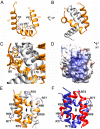Structure and dsRNA-binding activity of the Birnavirus Drosophila X Virus VP3 protein
- PMID: 33239452
- PMCID: PMC7851550
- DOI: 10.1128/JVI.02166-20
Structure and dsRNA-binding activity of the Birnavirus Drosophila X Virus VP3 protein
Abstract
The Birnavirus multifunctional protein VP3 plays an essential role coordinating the virus life cycle, interacting with the capsid protein VP2, with the RNA-dependent RNA polymerase VP1 and with the dsRNA genome. Furthermore, the role of this protein in controlling host cell responses triggered by dsRNA and preventing gene silencing has been recently demonstrated. Here we report the X-ray structure and dsRNA-binding activity of the N-terminal domain of Drosophila X virus (DXV) VP3. The domain folds in a bundle of three α-helices and arranges as a dimer, exposing to the surface a well-defined cluster of basic residues. Site directed mutagenesis combined with Electrophoretic Mobility Shift Assays (EMSA) and Surface Plasmon Resonance (SPR) revealed that this cluster, as well as a flexible and positively charged region linking the first and second globular domains of DXV VP3, are essential for dsRNA-binding. Also, RNA silencing studies performed in insect cell cultures confirmed the crucial role of this VP3 domain for the silencing suppression activity of the protein.IMPORTANCE The Birnavirus moonlighting protein VP3 plays crucial roles interacting with the dsRNA genome segments to form stable ribonucleoprotein complexes and controlling host cell immune responses, presumably by binding to and shielding the dsRNA from recognition by the host silencing machinery. The structural, biophysical and functional data presented in this work has identified the N-terminal domain of VP3 as responsible for the dsRNA-binding and silencing suppression activities of the protein in Drosophila X virus.
Copyright © 2020 American Society for Microbiology.
Figures








Similar articles
-
Structure of the aminoterminal domain of the birnaviral multifunctional VP3 protein and its unexplored critical role.PNAS Nexus. 2024 Nov 20;3(12):pgae521. doi: 10.1093/pnasnexus/pgae521. eCollection 2024 Dec. PNAS Nexus. 2024. PMID: 39677362 Free PMC article.
-
Infectious bursal disease virus capsid protein VP3 interacts both with VP1, the RNA-dependent RNA polymerase, and with viral double-stranded RNA.J Virol. 2002 Nov;76(22):11301-11. doi: 10.1128/jvi.76.22.11301-11311.2002. J Virol. 2002. PMID: 12388690 Free PMC article.
-
Inhibition of antiviral innate immunity by birnavirus VP3 protein via blockage of viral double-stranded RNA binding to the host cytoplasmic RNA detector MDA5.J Virol. 2014 Oct;88(19):11154-65. doi: 10.1128/JVI.01115-14. Epub 2014 Jul 16. J Virol. 2014. PMID: 25031338 Free PMC article.
-
Infectious Bursal Disease Virus Hijacks Endosomal Membranes as the Scaffolding Structure for Viral Replication.J Virol. 2018 May 14;92(11):e01964-17. doi: 10.1128/JVI.01964-17. Print 2018 Jun 1. J Virol. 2018. PMID: 29540593 Free PMC article.
-
Structure of a VP1-VP3 complex suggests how birnaviruses package the VP1 polymerase.J Virol. 2013 Mar;87(6):3229-36. doi: 10.1128/JVI.02939-12. Epub 2013 Jan 2. J Virol. 2013. PMID: 23283942 Free PMC article.
Cited by
-
Insect-pathogen crosstalk and the cellular-molecular mechanisms of insect immunity: uncovering the underlying signaling pathways and immune regulatory function of non-coding RNAs.Front Immunol. 2023 Aug 24;14:1169152. doi: 10.3389/fimmu.2023.1169152. eCollection 2023. Front Immunol. 2023. PMID: 37691928 Free PMC article. Review.
-
Structure of the aminoterminal domain of the birnaviral multifunctional VP3 protein and its unexplored critical role.PNAS Nexus. 2024 Nov 20;3(12):pgae521. doi: 10.1093/pnasnexus/pgae521. eCollection 2024 Dec. PNAS Nexus. 2024. PMID: 39677362 Free PMC article.
-
CDK12 antagonizes a viral suppressor of RNAi to modulate antiviral RNAi in Drosophila.mBio. 2025 Jan 8;16(1):e0286824. doi: 10.1128/mbio.02868-24. Epub 2024 Nov 27. mBio. 2025. PMID: 39601580 Free PMC article.
References
-
- Delmas B, Mundt E, Vakharia VN, Wu JL. 2011. Birnaviridae, p 499–507. In King AMQ, Adams MJ, Carstens EB, Lefkowitz EJ (ed), Virus taxonomy: classification and nomenclature of viruses. Ninth report of the International Committee on Taxonomy of Viruses. Elsevier Academic Press, San Diego, CA.
LinkOut - more resources
Full Text Sources
Other Literature Sources

